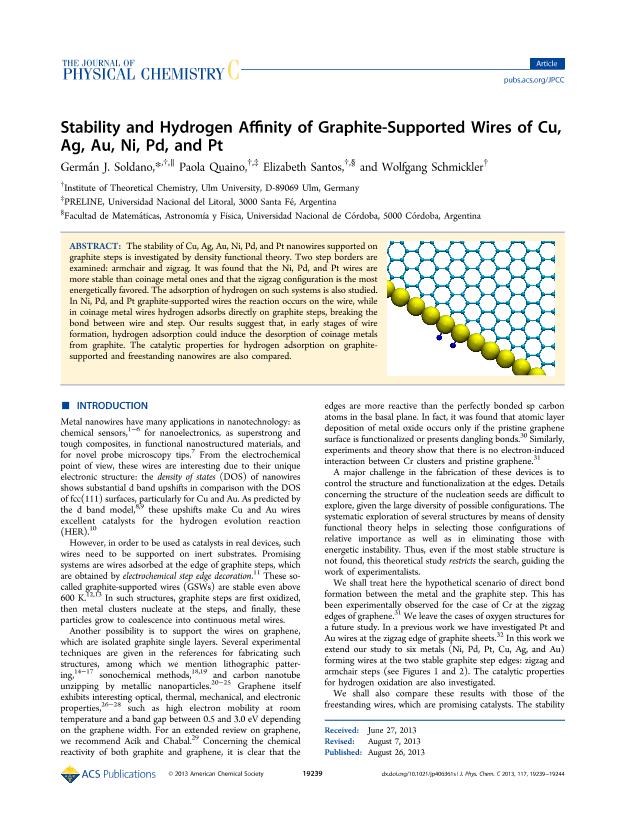Mostrar el registro sencillo del ítem
dc.contributor.author
Soldano, Germán

dc.contributor.author
Quaino, Paola Monica

dc.contributor.author
Santos, Elizabeth del Carmen

dc.contributor.author
Schmickler, Wolfgang

dc.date.available
2017-09-01T19:33:32Z
dc.date.issued
2013-08
dc.identifier.citation
Soldano, Germán; Quaino, Paola Monica; Santos, Elizabeth del Carmen; Schmickler, Wolfgang; Stability and Hydrogen Affinity of Graphite-Supported Wires of Cu, Ag, Au, Ni, Pd, and Pt; Amer Chemical Soc Inc; Journal of Physical Chemistry C; 117; 37; 8-2013; 19239-19244
dc.identifier.issn
1932-7447
dc.identifier.uri
http://hdl.handle.net/11336/23479
dc.description.abstract
The stability of Cu, Ag, Au, Ni, Pd, and Pt nanowires supported on graphite steps is investigated by density functional theory. Two step borders are examined: armchair and zigzag. It was found that the Ni, Pd, and Pt wires are more stable than coinage metal ones and that the zigzag configuration is the most energetically favored. The adsorption of hydrogen on such systems is also studied. In Ni, Pd, and Pt graphite-supported wires the reaction occurs on the wire, while in coinage metal wires hydrogen adsorbs directly on graphite steps, breaking the bond between wire and step. Our results suggest that, in early stages of wire formation, hydrogen adsorption could induce the desorption of coinage metals from graphite. The catalytic properties for hydrogen adsorption on graphite-supported and freestanding nanowires are also compared.
dc.format
application/pdf
dc.language.iso
eng
dc.publisher
Amer Chemical Soc Inc

dc.rights
info:eu-repo/semantics/openAccess
dc.rights.uri
https://creativecommons.org/licenses/by-nc-sa/2.5/ar/
dc.subject
Graphene
dc.subject
Metal Nanowires
dc.subject
Hydrogen
dc.subject
Catalysis
dc.subject.classification
Otras Ciencias Químicas

dc.subject.classification
Ciencias Químicas

dc.subject.classification
CIENCIAS NATURALES Y EXACTAS

dc.title
Stability and Hydrogen Affinity of Graphite-Supported Wires of Cu, Ag, Au, Ni, Pd, and Pt
dc.type
info:eu-repo/semantics/article
dc.type
info:ar-repo/semantics/artículo
dc.type
info:eu-repo/semantics/publishedVersion
dc.date.updated
2017-08-24T18:48:33Z
dc.journal.volume
117
dc.journal.number
37
dc.journal.pagination
19239-19244
dc.journal.pais
Estados Unidos

dc.description.fil
Fil: Soldano, Germán. Universidad Nacional de Córdoba. Facultad de Cs.químicas. Departamento de Química Teórica y Computacional; Argentina. Institute Of Theoretical Chemistry; Alemania. Consejo Nacional de Investigaciones Científicas y Técnicas; Argentina
dc.description.fil
Fil: Quaino, Paola Monica. Universidad Nacional del Litoral. Facultad de Ingeniería Química. Programa de Electroquímica Aplicada e Ingeniería Electroquímica; Argentina. Institute Of Theoretical Chemistry; Alemania. Consejo Nacional de Investigaciones Científicas y Técnicas. Centro Científico Tecnológico Conicet - Santa Fe; Argentina
dc.description.fil
Fil: Santos, Elizabeth del Carmen. Institute Of Theoretical Chemistry; Alemania. Universidad de Cordoba. Fac. de Matemática Astronomía y Física; España. Consejo Nacional de Investigaciones Científicas y Técnicas; Argentina
dc.description.fil
Fil: Schmickler, Wolfgang. Institute Of Theoretical Chemistry; Alemania
dc.journal.title
Journal of Physical Chemistry C

dc.relation.alternativeid
info:eu-repo/semantics/altIdentifier/url/http://pubs.acs.org/doi/abs/10.1021/jp406361s
dc.relation.alternativeid
info:eu-repo/semantics/altIdentifier/doi/http://dx.doi.org/10.1021/jp406361s
Archivos asociados
